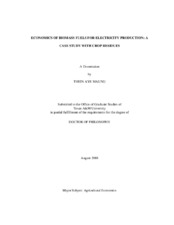| dc.contributor.advisor | McCarl, Bruce A. | |
| dc.creator | Maung, Thein Aye | |
| dc.date.accessioned | 2010-01-15T00:04:45Z | |
| dc.date.accessioned | 2010-01-16T01:01:40Z | |
| dc.date.available | 2010-01-15T00:04:45Z | |
| dc.date.available | 2010-01-16T01:01:40Z | |
| dc.date.created | 2008-08 | |
| dc.date.issued | 2009-05-15 | |
| dc.identifier.uri | https://hdl.handle.net/1969.1/ETD-TAMU-2860 | |
| dc.description.abstract | In the United Sates and around the world, electric power plants are among the biggest
sources of greenhouse gas emissions which the Intergovernmental Panel on Climate
Change argued was the main cause of climate change and global warming. This
dissertation explores the factors which may induce electricity producers to use biomass
fuels for power generation and thereby mitigate the impact of greenhouse gas emissions.
Analyses in this dissertation suggest that there are two important factors which will play
a major role in determining the future degree of bioelectricity production: the price of
coal and the future price of carbon emissions. Using The Forest and Agricultural Sector
Optimization Model—Green House Gas version (FASOMGHG) in a case study
examining the competitiveness of crop residues, this dissertation finds that crop residues
currently cost much more than coal as an electricity generation feedstock because they
have lower heat content and higher production /hauling costs. For them to become cost
competitive with coal, the combined costs of production and hauling must be cut by
more than half or the coal price needs to rise. In particular, for crop residues to have any
role in electricity generation either the price of coal has to increase to about $43 per ton
or the carbon equivalent price must rise to about $15 per ton.
The simulation results also show that crop residues with higher heat content such
as wheat residues will have greater opportunities in bioelectricity production than the
residues with lower heat content. In addition, the analysis shows that improvements in
crop yield do not have much impact on bioelectricity production. However, the energy
recovery efficiency does have significant positive impact on the bioelectricity
desirability but again only if the carbon equivalent price rises substantially. The analysis also shows the desirability of cofiring biomass as opposed to 100% replacement because
this reduces haling costs and increases the efficiency of heat recovery.
In terms of policy implications, imposing carbon emission restrictions could be
an important step in inducing electric power producers to include biofuels in their fuelmix
power generation portfolios and achieve significant greenhouse gas emission
reductions. | en |
| dc.format.medium | electronic | en |
| dc.format.mimetype | application/pdf | |
| dc.language.iso | en_US | |
| dc.subject | Crop Residues | en |
| dc.subject | Greenhouse gas | en |
| dc.subject | Carbon emissions | en |
| dc.title | Economics of biomass fuels for electricity production: a case study with crop residues | en |
| dc.type | Book | en |
| dc.type | Thesis | en |
| thesis.degree.department | Agricultural Economics | en |
| thesis.degree.discipline | Agricultural Economics | en |
| thesis.degree.grantor | Texas A&M University | en |
| thesis.degree.name | Doctor of Philosophy | en |
| thesis.degree.level | Doctoral | en |
| dc.contributor.committeeMember | Bessler, David A. | |
| dc.contributor.committeeMember | El-Halwagi, Mahmoud | |
| dc.contributor.committeeMember | Outlaw, Joe | |
| dc.type.genre | Electronic Dissertation | en |
| dc.type.material | text | en |
| dc.format.digitalOrigin | born digital | en |


